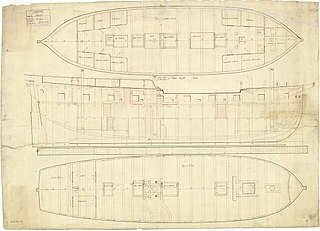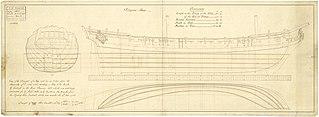The ship that became Mary Ann was built in 1772 in France and the British captured her c. 1778. Her name may have been Ariadne until 1786 when she started to engage in whaling. Next, as Mary Ann, she made one voyage transporting convicts to New South Wales from England. In 1794 the French captured her, but by 1797 she was back in her owners' hands. She then made a slave trading voyage. Next, she became a West Indiaman, trading between London or Liverpool to Demerara. It was on one of those voyages in November 1801 that a French privateer captured her.
The British Royal Navy purchased HMS Shark on the stocks in 1775. She was launched in 1776, and in 1778 converted to a fireship and renamed HMS Salamander. The Navy sold her in 1783. She then became the mercantile Salamander. In the 1780s she was in the northern whale fishery. In 1791 she transported convicts to Australia. She then became a whaling ship in the southern whale fishery for a number of years, before becoming a general transport and then a slave ship. In 1804 the French captured her, but the Royal Navy recaptured her. Although she is last listed in 1811, she does not appear in Lloyd's List (LL) ship arrival and departure (SAD) data after 1804.

HMS Rattler was a 16-gun sloop of the Royal Navy. Launched in March 1783, she saw service in the Leeward Islands and Nova Scotia before being paid off in 1792 and sold to whaling company Samuel Enderby & Sons. She made two voyages as a whaler and two as a slave ship before she was condemned in the Americas as unseaworthy in 1802. She returned to service though, sailing as a whaler in the northern whale fishery, sailing out of Leith. She continued whaling until ice crushed her in June 1830.
HMS Flirt was launched in 1782 but was completed too late to see any significant service in the American War of Independence. She then spent most of the years of peace in British waters. She sailed to Jamaica in 1791, but was laid up in Deptford in November 1792, and did not return to service before being sold in 1795. Daniel Bennett purchased her, had her almost rebuilt, and then employed her as a whaler in the Southern Whale Fishery. A French privateer captured her in 1803 as Flirt was returning to Britain from a whaling voyage.
Butterworth was launched in 1778 in France as the highly successful 32-gun privateer Américaine, of Granville. The British Royal Navy captured her early in 1781. She first appeared in a commercial role in 1784 as America, and was renamed in 1785 as Butterworth. She served primarily as a whaler in the Greenland whale fisheries. New owners purchased her in 1789. She underwent a great repair in 1791 that increased her size by almost 20%. She is most famous for her role in the "Butterworth Squadron", which took her and two ship's tenders on an exploration, sealing, otter fur, and whaling voyage to Alaska and the Pacific Coast of North America. She and her consorts are widely credited with being the first European vessels to enter, in 1794, what is now Honolulu harbour. After her return to England in 1795, Butterworth went on three more whaling voyages to the South Pacific, then Africa, and then the South Pacific again. In 1802 she was outward bound on her fourth of these voyage, this to the South Pacific, when she was lost.

HMS Stork was a 10-gun Alderney-class sloop of the Royal Navy which saw active service during the Seven Years' War. Launched in 1757, she was assigned to the Navy's Jamaica Station until August 1758 when she was captured by the French. She remained in French hands until being disarmed in 1759 and removed from service in 1760.
Britannia was built in South Carolina in 1772. Prior to 1798, Britannia sailed between London and South Carolina, or simply served as a transport. In 1798 she changed ownership and began a sequence of whaling voyages. Between 1798 and 1807 she made a number of whaling voyages to the South Seas whale fishery, and the coast of South Africa. On one of those voyages a French privateer captured her, but Britannia was recaptured almost immediately. Between 1808 and 1816, the last year in which she is listed, she returned to operating as a London-based transport.
Canada was launched at King's Yard in 1779 for the Royal Navy, which sold her circa 1782 at the end of the war. Her name while in Royal Navy service is unknown as of November 2022. John St Barbe purchased her and named her Adriatic, but renamed her Canada circa 1786. She made three seal hunting and whaling voyages between 1791 and 1799 under that name. On the first of these a French privateer captured her, but a British merchant ship recaptured her. She was lost at South Georgia in 1800 on her fourth voyage to the southern whale fishery.

HMS Diligence was a 10-gun Alderney-class sloop of the Royal Navy which saw active service during the Seven Years' War and the American Revolutionary War. Launched in 1756, she was a successful privateer hunter off the coast of France before being reassigned to North American waters in 1763. Fifteen years later she was briefly refitted as a receiving ship for press ganged sailors brought into Sheerness Dockyard, before being re-registered in August 1779 as the fireship Comet.
Eliza was built in Spain in 1794 under another name and taken as a prize circa 1800. She then made one voyage for the British East India Company (EIC). On her return she made one voyage to Timor as a whaler. She next became a West Indiaman. In 1810 she apparently was sold to Portuguese interests and who continued to sail her under the name Courier de Londres. She is last listed in 1814.
HMS Coquette was launched in 1807 and spent her naval career patrolling in the Channel and escorting convoys. In 1813 she engaged an American privateer in a notable but inconclusive single-ship action. The Navy put Coquette in ordinary in 1814 and sold her in 1817. She became a whaler and made five whaling voyages to the British southern whale fishery before she was lost in 1835 on her sixth.
Robust was built in France in 1779. The British captured her in 1781 and she was registered at Liverpool in 1783. She first entered Lloyd's Register in 1789 as whaler in the northern whale fishery. Then in December 1788 she left on the first of three voyages as a slave ship in the triangular trade in enslaved people. On her third voyage as a slave ship Robust captured a French slave ship and recaptured two British slave ships that a French privateer had captured earlier. After her third voyage as a slaver owners shifted her registry to Bristol and she then made two voyages to the southern whale fishery. She returned from the second voyage in 1797 and is last listed in 1798.
HMS Hazard was launched in 1749 For the Royal Navy as brig-rigged sloop. She had a 30-plus year career with the navy, during which she captured several small French privateers. At the end of the American War of Independence, the navy sold her and she became the merchantman Joseph. After almost a decade as a merchantman trading with Spain, a new owner made a whaler of her. She made seven whaling voyages and was no longer listed after 1804, two years after her return from her last whaling voyage.
Commerce was launched at Liverpool in 1791. She was initially a West Indiaman. New owners in 1795 sent Commerce to the southern whale fishery in 1796. The Spanish captured her in 1797, but by 1799 she had returned to British ownership. She then traded generally until a French privateer captured her in 1805.
HMS Harpy was launched at Liverpool in 1777, the British Royal Navy having purchased her on the stocks. The Navy sold her in 1783. As Harpy she made voyages to the northern whale fishery, and one voyage as a whaler in the British southern whale fishery. The Sierra Leone Company then purchased her. A French naval squadron captured her in September 1794. The French Navy briefly took her into service as Harcourt, and then Harpie. She was struck in 1796.
Tartar was built in France in 1778, almost surely under another name. She was taken in prize and appears under British ownership in 1780. After a short career as a privateer, she made a voyage between 1781 and 1783 as an extra East Indiaman for the British East India Company (EIC). She then became a whaler in the northern whale fishery. After whaling she traded with the Baltic and then served as a London-based transport. She was probably lost in 1799, and was last listed in 1801. If Tartar is the vessel lost in 1799, in 1796 French warships captured her, but the Royal Navy quickly recaptured her.
Fortune was a French privateer launched at Bordeaux in 1800 and taken that same year. She immediately made one voyage as a whaler and privateer. She then made two voyages as a slave ship in the triangular trade in enslaved people. After the end of the British enslaving trade Fortune continued to trade with Africa and with South America. She was last listed in 1816.
HMS Spy was a Bonetta-class sloop launched at Rotherhithe in 1756 for the Royal Navy. The Navy sold her in 1773. From 1776, or perhaps earlier she was a transport. Then from 1780 to 1783, as Mars, she was first a privateer and then a slave ship, engaged in the triangular trade in enslaved persons. Between 1783 and 1787 her name was Tartar, and she traded with the Mediterranean. From 1787, as Southampton, she was a whaler in the British southern whale fishery. She made at least four complete whaling voyages and was last listed in 1792.

HMS Granado was launched at Harwich in 1742, during the War of the Austrian Succession as a sloop-of-war. During this war she captured a French privateer. During the Seven Years' War she served both as a sloop and as a bomb vessel, and participated in naval operations off the coast of France and in the West Indies. When the Navy sold her in 1763 she became the mercantile Prince Frederick. Around 1775 she became the whaler Prudence, sailing in the British northern whale fishery. Around 1781 she became a government transport and was wrecked on 20 May 1782 on the coast of India.
Chaser was built in the East Indies in 1778. The Royal Navy purchased her in 1781 and commissioned her as HMS Chaser. A French frigate captured her in 1782 but the Royal Navy recaptured her in 1783 and took her back into service. She was present at a major battle and then sailed to England where the Navy sold her in 1784. As the mercantile Chaser she made five or six voyages as a whaler in the British northern whale fishery and then two to the southern whale fishery. On her way home from the second a French privateer captured her, but some of her crew recaptured her. Next, she began trading with Honduras but was wrecked in late 1795 as she was returning from there to London.




